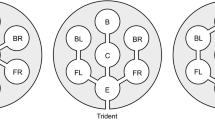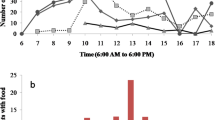Abstract
The collective activities of social insects often result in the formation of complex structures. Previous studies have revealed the building mechanisms of various species, where sophisticated colony-level structures emerge from the interactions among individuals. However, little is known about the building behaviors of primitive species, which would give us an insight into the evolutionary processes that gave rise to collective building of sophisticated structures. Therefore, in this study, I investigated the building behavior of the primitive termite Zootermopsis nevadensis, which constructs simple barricades to plug the openings to its nests. Observation of the time course of barricade construction showed that the building dynamics followed a logistic pattern, suggesting that their collective building involves an amplification phase, which plays an important role in self-organized building activities in social insects. Moreover, this species exhibited highly skewed task allocation during construction. Together, these results suggest that this primitive species possesses building mechanisms similar to species with more sophisticated collective behaviors.





Similar content being viewed by others
References
Camazine S, Deneubourg J-L, Franks NR et al (2001) Self-organization in biological systems. Princeton University Press, Princeton
Bonabeau E, Theraulaz G, Deneubourg J-L et al (1998) A model for the emergence of pillars, walls and royal chambers in termite nests. Philos Trans R Soc Lond B 353:1561–1576
Theraulaz G, Bonabeau E, Deneubourg J-L (1998) The origin of nest complexity in social insects. Complexity 3:15–25
Mizumoto N, Kobayashi K, Matsuura K (2015) Emergence of intercolonial variation in termite shelter tube patterns and prediction of its underlying mechanism. R Soc Open Sci 2:150360
Khuong A, Gautrais J, Perna A et al (2016) Stigmergic construction and topochemical information shape ant nest architecture. Proc Natl Acad Sci USA 113:1303–1308
Grassé P-P (1959) La reconstruction du nid et les coordinations interindividuelles chez Bellicositermes natalensis et Cubitermes sp. la théorie de la stigmergie: Essai d’interprétation du comportement des termites constructeurs. Insectes Soc 6:41–80
Emerson EA (1938) Termite nests: a study of the phylogeny of behavior. Ecol Monogr 8:247–284
Abe T (1987) Evolution of life types in termites. In: Kawano S, Connell J, Hidaka T (eds) Evolution and coadaptation in biotic communities. University of Tokyo Press, Tokyo, pp 125–148
Mizumoto N, Matsuura K (2013) Colony-specific architecture of shelter tubes by termites. Insect Soc 60:525–530
Yashiro T, Mitaka Y, Nozaki T, Matsuura K (2018) Chemical and molecular identification of the invasive termite Zootermopsis nevadensis (Isoptera: Archotermopsidae) in Japan. Appl Entomol Zool 53:215–221
Howse PE (1968) On the division of labour in the primitive termite Zootermopsis nevadensis (Hagen). Insectes Soc 15:45–50
Buhl J, Deneubourg J-L, Grimal A, Theraulaz G (2005) Self-organized digging activity in ant colonies. Behav Ecol Sociobiol 58:9–17
Buhl J, Gautrais J, Deneubourg JL, Theraulaz G (2004) Nest excavation in ants: Group size effects on the size and structure of tunneling networks. Naturwissenschaften 91:602–606
Tenczar P, Lutz CC, Rao VD et al (2014) Automated monitoring reveals extreme interindividual variation and plasticity in honeybee foraging activity levels. Anim Behav 95:41–48
Morisita M (1962) Iδ-Index, a measure of dispersion of individuals. Res Popul Ecol 4:1–7
Yang R-L, Su N-Y, Bardunias PM (2009) Individual task load in tunnel excavation by the Formosan subterranean termite (Isoptera: Rhinotermitidae). Ann Entomol Soc Am 102:906–910
Toffin E, Kindekens J, Deneubourg J-L (2010) Excavated substrate modulates growth instability during nest building in ants. Proc R Soc Lond B 277:2617–2625
Toffin E, Dl Paolo D, Campo A et al (2009) Shape transition during nest digging in ants. Proc Natl Acad Sci USA 106:18616–18620
Bourguignon T, Chisholm RA, Evans TA (2016) The termite worker phenotype evolved as a dispersal strategy for fertile wingless individuals before eusociality. Am Nat 187:372–387
Bordereau C, Pasteels J (2011) Pheromones and chemical ecology of dispersal and foraging in termites. In: Bignell DE, Roisin Y, Lo N (eds) Biology of termites: a modern synthesis. Springer, Berlin, pp 279–320
Acknowledgements
I thank K. Matsuura, S. Dobata, H. Nishimori, R. Fujisawa, N. Nagaya, M. S. Abe, H. Shimoji and T. Nozaki for helpful discussion. I also thank J. Uto and T. Inagaki for help of collecting termites. Enago (http://www.enago.jp) performed the English language review. I completed the manuscript, supported by JSPS Overseas Research Fellowships (supervision by S. C. Pratt). This study was supported by a Research Fellowship for Young Scientists from the Japan Society for the Promotion of Science (JSPS) no. 15J02767.
Author information
Authors and Affiliations
Corresponding author
About this article
Cite this article
Mizumoto, N. Barricade construction by primitive termites: task allocation and evolutionary perspectives. Artif Life Robotics 23, 469–473 (2018). https://doi.org/10.1007/s10015-018-0474-6
Received:
Accepted:
Published:
Issue Date:
DOI: https://doi.org/10.1007/s10015-018-0474-6




